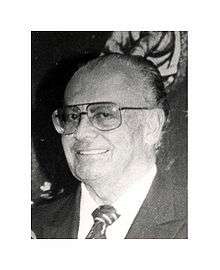Javier Arias Stella
| Javier Arias Stella | |
|---|---|
 | |
| Occupation | Pathologist |
Javier Arias Stella (born August 2, 1924) is a Peruvian pathologist[1] who discovered the eponymous "Arias-Stella reaction" (or "phenomenon").[2]
Education
Arias Stella's undergraduate studies were done first at the San Marcos National University's School of Science in Peru from 1942 to 1944 and then at the Faculty of Medicine from 1945 to 1951, from which he earned his bachelor's in 1951. His doctorate was also earned from that faculty in 1959.[3]
Research
Arias-Stella reaction
Arias-Stella found that a reaction previously thought of as a cancer in the endometrium was rather a normal reactions of hormones from placental tissue.[2][3][4][5] It can also refer to changes occurring in the cervix.[6]
Altitude changes in anatomy and histology
Later in his life, he became involved in researching how altitude changes in the Andes affected anatomy and histology in human beings, men specifically. It had long been thought that the multiple cases of pulmonary hypertension in Andes men came from the altitude they lived in. Arias Stella's research showed that "hypoxia-induced thickening of the pulmonary arteriolar walls" was the main cause for the hypertension. Considering that the natives had no access to vasodilators, their cases of hypertension were found to be different from known cases of acute hypoxic pulmonary vasoconstriction.[7]
Career
Early career
Arias Stella began teaching as an instructor in pathology by 1949 in the same university and faculty that he already was attending. Over time he became a senior lecturer in clinical pathology. In 1961, he founded the Universidad Peruana Cayetano Heredia, where he began as an associate professor of pathology. By 1969, he was the principal professor and then head of the pathology department by 1975. He became the consulting professor for the National University of Caracas in 1974 and then the same for the Central University of Venezuela in 1975. He continued to have various professional standings in many hospitals in both South America and the United States. He also traveled as a visiting professor to many universities in the United States.[3]
He was asked to join multiple medical societies, including the American Association of Pathologists and the International Academy of Pathologists then went on to found the International Society of Gynecological Pathology, the Latin American Society of Pathology, and the Peruvian Society of Pathology.[3]
Late career
He was public health minister in 1963–65 and 1966–68 and became the foreign minister of Peru from 1980 to 1983 because of his involvement in the Belaunde regime.[8][9] Javier was the foreign minister during the Paquisha War in 1981 with Ecuador. During the early skirmishes over an outpost in Paquisha, Javier was quoted in newspapers as stating that Peru would proceed to recapture the rest of the territory that Ecuadorian forces were encroaching on.[10]
In 1984 and 1985, he served as the President of the United Nations Security Council.[11]
Family
He married Nancy Castillo Arias Stella and had four children.[3]
See also
References
- ↑ "journals.lww.com". Retrieved 2010-03-16.
- 1 2 doctor/265 at Who Named It?
- 1 2 3 4 5 Career - Pontificia Universidad Catolica Del Peru (machine translation)
- ↑ Wicherek L, Basta P, Pitynski K, et al. (April 2009). "The characterization of the subpopulation of suppressive B7H4(+) macrophages and the subpopulation of CD25(+) CD4(+) and FOXP3(+) regulatory T-cells in decidua during the secretory cycle phase, Arias Stella reaction, and spontaneous abortion - a preliminary report". Am. J. Reprod. Immunol. 61 (4): 303–12. doi:10.1111/j.1600-0897.2009.00696.x. PMID 19260861.
- ↑ Arias-Stella J (January 2002). "The Arias-Stella reaction: facts and fancies four decades after". Adv Anat Pathol. 9 (1): 12–23. doi:10.1097/00125480-200201000-00003. PMID 11756756.
- ↑ Félix A, Nogales FF, Arias-Stella J (March 2010). "Polypoid endometriosis of the uterine cervix with Arias-Stella reaction in a patient taking phytoestrogens". Int. J. Gynecol. Pathol. 29 (2): 185–8. doi:10.1097/PGP.0b013e3181b7015e. PMID 20173505.
- ↑ Reeves JT, Grover RF (January 2005). "Insights by Peruvian scientists into the pathogenesis of human chronic hypoxic pulmonary hypertension". J. Appl. Physiol. 98 (1): 384–9. doi:10.1152/japplphysiol.00677.2004. PMID 15591308.
- ↑ The Shining Path: a history of the millenarian war in Peru, p. 155, at Google Books
- ↑ "Inter-American Consultative Group on Coca Leaf Problems, Lima, 14-21 December 1964" UNODC
- ↑ "Peruvian Forces Recover Territory" The Victoria Advocate
- ↑ "Presidents (1980–1989) : Security Council (SC) : United Nations (UN)". Retrieved 2010-03-16.
External links
- Stamp of Arias-Stella
- "Prologue" - Instituto de Patologia y Biologia Molecular
- "Success Story: SecondSlide Streamlines the Consultation Process, Improves Turnaround Time" - Google Docs
- "Javier Arias Stella, world-renowned researcher" - El Comercio
- Agreement for the recovery and return of stolen archaeological, historical and cultural properties. Signed at Lima on 15 September 1981
- "Worldwide Report: Law of the Sea" Page 13 - Google Docs